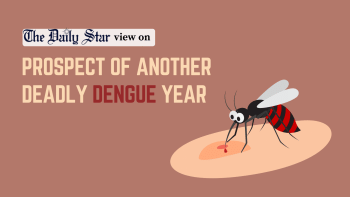Time to strengthen the fight against dengue

Earlier this month, the sound of thunder and lightning with torrential rain brought much relief from the month-long heatwave of April. But my joy was cut short by the high-pitched buzz of a mosquito. It was a reminder that dengue season was around the corner. According to a recent report in this daily, experts are predicting a worse dengue situation this year compared to last year.
Such a prediction is concerning as Bangladesh already witnessed a record number of dengue-related deaths and hospitalisations last year. According to data from the Directorate General of Health Services, more than 1,700 people, including 170 children, died from the vector-borne disease last year with hospitalisations surpassing three lakh across the country.
The number of dengue-related deaths in the first four months of this year is almost double of what it was during the same period last year. Additionally, the disease, which is mostly prevalent in urban and semi-urban areas because of the widespread presence of stagnant water bodies—which are the favourite breeding grounds of Aedes mosquitoes—appears to have made its way to the villages too. A few years ago, experts warned about a certain type of Aedes (Aedes albopictus), which lay eggs on the edges of forested or vegetated areas, besides containers with stagnant water. They suspected an association between those Aedes mosquitoes and the increasing number of cases in rural areas. This is a development that adds to the level of concern.
Although plenty of rest, liquid intake and painkillers can be used to treat mild dengue, severe cases that may include breathing difficulty, persistent vomiting or bleeding through gums require hospitalisation. Patients with such symptoms often need intravenous fluid, constant medical monitoring, and even blood transfusion. Unlike the cities, healthcare facilities in villages are often not well-equipped or even well-staffed, rendering them incapable of treating dengue patients. If an endemic breaks out in the villages, people will have little choice but to move to the already overwhelmed hospitals in the cities for treatment. Last year's situation had pushed the city hospitals to their limits with cases mostly from urban centres and surrounding areas. One can imagine what the situation will be if dengue spreads in the villages at the same rate as it occurs in urban areas.
Although last week's report in this daily quoted the director of Communicable Disease Control Programme at the DGHS saying that they had instructed upazila level doctors not to refer patients to the capital unless necessary, the question remains as to whether our upazila-level healthcare facilities are equipped to treat serious patients. Rather than ad hoc instructions, a clear guideline for our healthcare system to tackle severe outbreaks should be implemented. But are we preparing any such strategy at the national level?
Dengue has been affecting public health in Bangladesh for decades, yet we do not have an effective national prevention strategy in place. Unscientific methods have often been floated as solutions to control the vector. Besides, there is no coordination between different institutions that are responsible for prevention and control of dengue. Multiple experts at various times have called for implementation of measures successful in cities of neighbouring countries with weather patterns similar to Dhaka. There is no reason to believe that those suggestions have been taken into account.
Even the job of creating awareness among people to keep possible Aedes breeding grounds clean does not appear to happen year-round. It is hard to find a road, street or electric pole without a political poster praising some leader or congratulating them for something. More lives could perhaps have been saved had those posters displayed preventative methods for dengue instead. Not just posters, broadcasting infomercials on dengue prevention in mass media should not be limited to just when the disease claims lives in dozens. More efforts should be given to continue raising awareness throughout the year in a coordinated way. Additionally, city corporations and municipal offices themselves should take stock of their buildings, equipment, and assets and set examples by making sure that those do not become mosquito breeding grounds.
Lastly, the government should take up funding research projects on dengue and Aedes mosquitoes, and not shy away from publishing the findings or implementing recommendations by experts from diverse sectors. It may be a little late to start doing what the authorities have stalled for so long, but it is not too late. Each and every life lost from dengue is preventable, at least it should be in the 21st century. Besides, Bangladesh has succeeded in eradicating several diseases in the past. Why not dengue? Why should we open the newspaper and are faced with a news report predicting a deadlier scenario, not a hopeful one?
Imagine reading a report that mentions experts forecasting a declining trend of the disease because of effective measures taken by the authorities in a coordinated way. Is that an impossible dream?
Tamanna Khan is a member of the editorial team at The Daily Star.
Views expressed in this article are the author's own.
Follow The Daily Star Opinion on Facebook for the latest opinions, commentaries and analyses by experts and professionals. To contribute your article or letter to The Daily Star Opinion, see our guidelines for submission.

 For all latest news, follow The Daily Star's Google News channel.
For all latest news, follow The Daily Star's Google News channel. 











Comments